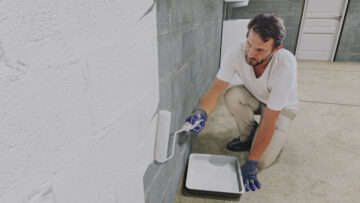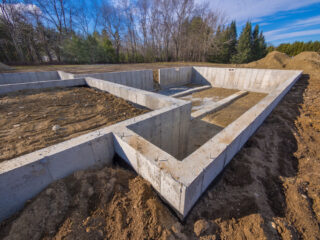Securing a below-grade space, such as a basement or foundation, from water infiltration is crucial in safeguarding against structural damage and potential mold growth. Two primary methods — interior (negative) and exterior (positive) waterproofing — offer distinct advantages and are influenced by various factors, including budget constraints, water severity, and property specifics.

Foundation waterproofing during construction acts as the initial defense against water infiltration, preserving the building’s structural integrity and ensuring a dry living environment. Utilizing a liquid-applied waterproofing system suitable for both sides of the foundation provides numerous unique benefits:
Versatility: The flexibility to apply the waterproofing material on various foundation types, including concrete and masonry, caters to diverse construction requirements and specific site conditions, ensuring comprehensive protection.
Comprehensive Protection: Dual-sided application prevents water intrusion from both exterior groundwater seepage and interior moisture buildup, ensuring complete safeguarding of the foundation.
Redundancy: Implementing waterproofing on both sides establishes a backup plan in case of one side’s failure or compromise, offering an extra layer of security, particularly in critical areas like basements.
Maintenance and Repairs: Accessibility for maintenance and repairs from both the inside and outside enhances convenience and cost-effectiveness, allowing for efficient upkeep of the waterproofing system.
Improved Energy Efficiency: Proper foundation waterproofing contributes to enhanced energy efficiency by curbing moisture intrusion and minimizing the risk of mold and mildew growth, fostering a healthier indoor environment.
Longevity: The application of liquid waterproofing on both sides effectively extends the foundation’s lifespan by shielding it from potential water damage that may weaken the materials over time.
Breathability: Opting for a waterproofing material with an appropriate perm rating facilitates the controlled release of moisture vapor, maintaining the structural integrity and insulation of the building components, especially in regions with varying temperature and humidity levels.
Key Considerations for Negative Side Waterproofing:
Evaluate the “perm rating” of the waterproofing material to ensure proper moisture management within the building envelope, allowing controlled release of moisture vapor to prevent issues like mold growth and compromised indoor air quality.

DRYLOK® Masonry Waterproofer serves as an ideal choice for both positive and negative side waterproofing, offering a comprehensive solution that effectively manages hydrostatic pressure while permitting the escape of water vapor to prevent wall structure damage.
For an easy and cost-effective approach to safeguard your home against potential water damage, consider applying a reliable liquid waterproofer like DRYLOK® Masonry Waterproofer, ensuring a secure and dry living space for the long term.






